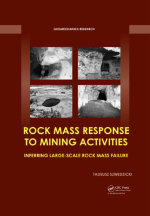Добрый день, Коллеги. Важное сообщение, просьба принять участие. Музей Ферсмана ищет помощь для реставрационных работ в помещении. Подробности по ссылке
Geomechanics research. Rock mass response to mining activities. Inferring large-scale rock mass failure / Исследования в области геомеханики. Реакция горного массива на добычу полезных ископаемых. Вывод о крупномасштабном разрушении горной массы
Just a few days after I started working at a deep underground hard rock mine as a geotechnical engineer, a double fatality happened. Two miners carrying a heavy pump up a decline were killed by a rockfall. Investigation that took place described the accident as “unpredictable” and stated that the support was adequate for the prevailing conditions. One day, soon after the rockfall, whe I was walking up the decline, I noticed that at that particular spot there were some wet patches at the back and some water trickling at one sidewall. After a few walks, I noticed the width of the decline was about half a metre wider than in other places, which wasn’t clearly visible because of irregular walls caused by blasting. After thorough inspection, I realised that the rockfall was in a fault zone. The rock mass within the fault (which was about 5 m wide) was similar to the neighbouring country rock but was highly jointed. All these observations made me think if that rockfall was really unpredictable. That accident was a reminder that the paramount objective of mining geomechanics is to ensure safety of mining personnel. This marked the beginning of my geotechnical quest – to determine whether we are in fact capable of reading the signs of rock mass response to mining . . . and therefore, predicting potential geotechnical hazards such as failure of rock around mining excavation or even potential disasters like ground collapse, rockburst or inundation?
My quest has been pursued globally in mines in Europe (Poland), Africa (Zambia, Zimbabwe, Republic of South Africa), and Australasia (Papua New Guinea, Indonesia, and Australia). <...>




